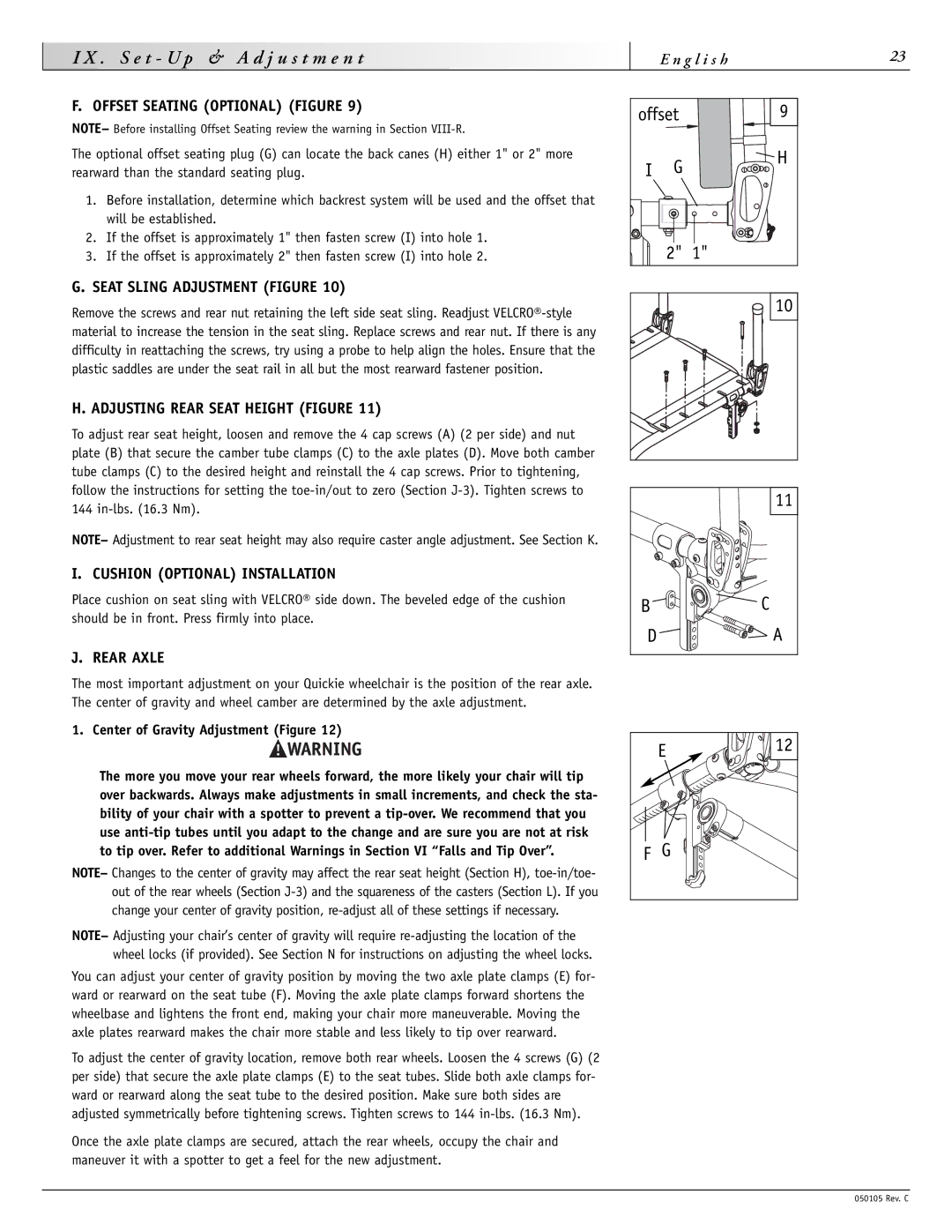
|
|
| I | X | . |
| S | e | t | - | U | p | & |
| A | d | j u | s | t | m | e | n t |
|
|
|
|
|
|
|
|
|
|
|
|
|
|
|
|
|
|
|
|
|
|
| E n g l i s h | 23 |
F. OFFSET SEATING (OPTIONAL) (FIGURE 9)
NOTE– Before installing Offset Seating review the warning in Section
The optional offset seating plug (G) can locate the back canes (H) either 1" or 2" more rearward than the standard seating plug.
1.Before installation, determine which backrest system will be used and the offset that will be established.
2.If the offset is approximately 1" then fasten screw (I) into hole 1.
3.If the offset is approximately 2" then fasten screw (I) into hole 2.
G. SEAT SLING ADJUSTMENT (FIGURE 10)
Remove the screws and rear nut retaining the left side seat sling. Readjust
H. ADJUSTING REAR SEAT HEIGHT (FIGURE 11)
To adjust rear seat height, loosen and remove the 4 cap screws (A) (2 per side) and nut plate (B) that secure the camber tube clamps (C) to the axle plates (D). Move both camber tube clamps (C) to the desired height and reinstall the 4 cap screws. Prior to tightening, follow the instructions for setting the
NOTE– Adjustment to rear seat height may also require caster angle adjustment. See Section K.
I. CUSHION (OPTIONAL) INSTALLATION
Place cushion on seat sling with VELCRO® side down. The beveled edge of the cushion should be in front. Press firmly into place.
J. REAR AXLE
The most important adjustment on your Quickie wheelchair is the position of the rear axle. The center of gravity and wheel camber are determined by the axle adjustment.
1. Center of Gravity Adjustment (Figure 12)
The more you move your rear wheels forward, the more likely your chair will tip over backwards. Always make adjustments in small increments, and check the sta- bility of your chair with a spotter to prevent a
NOTE– Changes to the center of gravity may affect the rear seat height (Section H),
NOTE– Adjusting your chair’s center of gravity will require
You can adjust your center of gravity position by moving the two axle plate clamps (E) for- ward or rearward on the seat tube (F). Moving the axle plate clamps forward shortens the wheelbase and lightens the front end, making your chair more maneuverable. Moving the axle plates rearward makes the chair more stable and less likely to tip over rearward.
To adjust the center of gravity location, remove both rear wheels. Loosen the 4 screws (G) (2 per side) that secure the axle plate clamps (E) to the seat tubes. Slide both axle clamps for- ward or rearward along the seat tube to the desired position. Make sure both sides are adjusted symmetrically before tightening screws. Tighten screws to 144
Once the axle plate clamps are secured, attach the rear wheels, occupy the chair and maneuver it with a spotter to get a feel for the new adjustment.
offset | 9 | |
I | G | H |
| ||
| 2" | 1" |
|
| 10 |
| 11 |
B | C |
D | A |
| E | 12 |
|
| |
F | G |
|
050105 Rev. C
